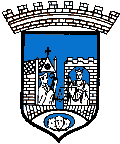

|
TOURING TRONDHEIM |
|
The Stead of Blessing carries many names. Trondheim, Trondhjem, Drontheim, and Nidaros are the most known. Lets take small walk through the city, following the pictures various people have laid out as a path for us on the net. These are all images someone else have wanted to show of their homestead. |
[A pictorial walk of the newly reshined docklands area, which is now my occupation, can be found here]
 The town square is dominated by a large idol statue of the founder
of this city, king Olav Trygvasson. Peculiar then, that the only
picture of this phallic town symbol on the net is very small.
A Swedish art historian once commented this statue as fascist relic which ought to be
destroyed at once. Without hesitation, the city council
decided to employ that guy. The king has a nice bloody sword and
beheaded slave beside him. Now this is of course not the
true founder of Trondheim. The king only stopped to eat in a nice little
village and then decided to turn that ensemble of shacks into a great city called Nidaros.
The locals had of course known that this was the heart of Norway
for centuries. This small decision is somewhat modestly celebrated
during the 1000-year anniversary in 1997.
The town square is dominated by a large idol statue of the founder
of this city, king Olav Trygvasson. Peculiar then, that the only
picture of this phallic town symbol on the net is very small.
A Swedish art historian once commented this statue as fascist relic which ought to be
destroyed at once. Without hesitation, the city council
decided to employ that guy. The king has a nice bloody sword and
beheaded slave beside him. Now this is of course not the
true founder of Trondheim. The king only stopped to eat in a nice little
village and then decided to turn that ensemble of shacks into a great city called Nidaros.
The locals had of course known that this was the heart of Norway
for centuries. This small decision is somewhat modestly celebrated
during the 1000-year anniversary in 1997.
 This picture of an average side street city house, is on the
other side quite large. This is from Jomfrugata ("Virgin Street"). The
owner also publishes
details on
the innings of their adorable home.
This picture of an average side street city house, is on the
other side quite large. This is from Jomfrugata ("Virgin Street"). The
owner also publishes
details on
the innings of their adorable home.
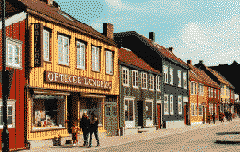 The small wooden houses are typical of the city. They used to
be cheap housing for the poor, but now they are luxurious
apartments for the nouveaux riches — or simply poorly rehabilitated
student rooms.
The small wooden houses are typical of the city. They used to
be cheap housing for the poor, but now they are luxurious
apartments for the nouveaux riches — or simply poorly rehabilitated
student rooms.
 The tram! This is the most controversial part of Trondheim politics.
Currently there is a kind of truce between the anti-tram party
(led by the local newspaper and the bus company), and the pro-tram
party (led by those who use the tram, the environmentalists
and born-again communists gripping their only chance to be elected).
I am a true supporter of the tram. Buses stink.
The tram! This is the most controversial part of Trondheim politics.
Currently there is a kind of truce between the anti-tram party
(led by the local newspaper and the bus company), and the pro-tram
party (led by those who use the tram, the environmentalists
and born-again communists gripping their only chance to be elected).
I am a true supporter of the tram. Buses stink.
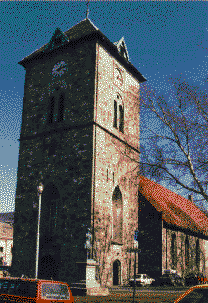 The church of Our Holy Mother. This is the most haunted place
in Mid-Norway, according to highly renown parapsychologists. Don't ask
me why, but maybe because there's a statue of Tordenskiold ("thundershield")
outside it -- the
city's answer to Francis Drake and lord Nelson. He killed a lot of people
and stole the whole Swedish fleet in a daring manoeuvrer in 1775. Afterwards
he got killed in cowardly manner by a mean German aristocrat. He
cheated in a duel over some petty insult or whatever.
The church of Our Holy Mother. This is the most haunted place
in Mid-Norway, according to highly renown parapsychologists. Don't ask
me why, but maybe because there's a statue of Tordenskiold ("thundershield")
outside it -- the
city's answer to Francis Drake and lord Nelson. He killed a lot of people
and stole the whole Swedish fleet in a daring manoeuvrer in 1775. Afterwards
he got killed in cowardly manner by a mean German aristocrat. He
cheated in a duel over some petty insult or whatever.
 The promenade street, Nordre. In the old days, before night clubs,
city boys walked on one side and city girls on the other. Then the
boys whistled, and the girls whined, and suddenly they had three
children and a furious mother-in-law. Today people walk all over the
street, the cool ones are sitting in the sun while the uncool ones are
shopping. Home of a famous cafe and patisserie, offering the probably
best chocolate you'll get north of Denmark, plus some local
specialties like marzipan-potatoes. Dove-ridden.
The promenade street, Nordre. In the old days, before night clubs,
city boys walked on one side and city girls on the other. Then the
boys whistled, and the girls whined, and suddenly they had three
children and a furious mother-in-law. Today people walk all over the
street, the cool ones are sitting in the sun while the uncool ones are
shopping. Home of a famous cafe and patisserie, offering the probably
best chocolate you'll get north of Denmark, plus some local
specialties like marzipan-potatoes. Dove-ridden.
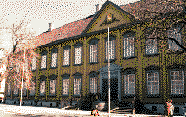 Stiftsgården was build by a megalomaniac widow about two hundred years
ago. At those times, the rich (and we speak money here) widows had
some kind of a competition, which was won by the one who built the largest
and most useless house. Too many of these wooden mansions were,
well, terminated, to make space for cosy concrete business buildings for the Social Democratic
Capitalists Boys' Club which silently controls the doings of this town. This
one survived, probably only because it's the king's local residence. It could be
that the fact that it is the largest wooden building in Northern Europe had some
influence, as well.
Stiftsgården was build by a megalomaniac widow about two hundred years
ago. At those times, the rich (and we speak money here) widows had
some kind of a competition, which was won by the one who built the largest
and most useless house. Too many of these wooden mansions were,
well, terminated, to make space for cosy concrete business buildings for the Social Democratic
Capitalists Boys' Club which silently controls the doings of this town. This
one survived, probably only because it's the king's local residence. It could be
that the fact that it is the largest wooden building in Northern Europe had some
influence, as well.
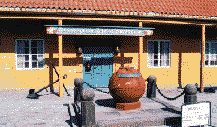 The seafarer's museum. Yes, that is
an undetonated bomb behind the chain fence. Well, a mine, then, to be
totally correct.
The seafarer's museum. Yes, that is
an undetonated bomb behind the chain fence. Well, a mine, then, to be
totally correct.
 The old city hall, for a time a fire station, but
now a part of the library. The library is
really something special, one of the thing I missed most when
I moved to the capital. In the capital, there is no real library, only
a pompous storage room for a small selection of popular books.
The old city hall, for a time a fire station, but
now a part of the library. The library is
really something special, one of the thing I missed most when
I moved to the capital. In the capital, there is no real library, only
a pompous storage room for a small selection of popular books.
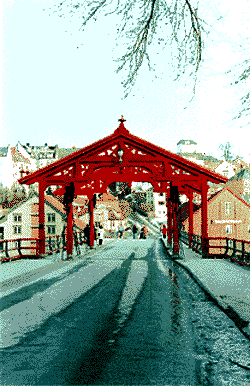 The portal of happiness. The town song deals a lot about missing
your girl friend and the beauty of the river beneath this bridge.
The river is actually quite gray and dull, except for the occasional
rainbow surfaces caused by diesel from the train garage further up.
Still, there's plenty of salmon, also in the parts running through
the town center.
The portal of happiness. The town song deals a lot about missing
your girl friend and the beauty of the river beneath this bridge.
The river is actually quite gray and dull, except for the occasional
rainbow surfaces caused by diesel from the train garage further up.
Still, there's plenty of salmon, also in the parts running through
the town center.
 Bryggene, the old harbour. They used to be busy trade houses 2-300 years ago -- their main functions today are beer serving, expensive lodgings. and being a general object for pyromaniacs.
And of course, they are models for the new wave of Norwegian architecture -- the one
which mainly constitutes in using as much glass as technically possible, with marble
or grey concrete stuck in between, according to the builder's economy. The finest harbour
houses are gone, sadly, the buildings are characteristic and beautiful.
Bryggene, the old harbour. They used to be busy trade houses 2-300 years ago -- their main functions today are beer serving, expensive lodgings. and being a general object for pyromaniacs.
And of course, they are models for the new wave of Norwegian architecture -- the one
which mainly constitutes in using as much glass as technically possible, with marble
or grey concrete stuck in between, according to the builder's economy. The finest harbour
houses are gone, sadly, the buildings are characteristic and beautiful.
 Bakklandet and the cathedral -- overview from the old worker's city, Bakklandet
When you walk out of the inner city through the portal of Happiness, you enter Bakklandet. The place was once a classical lower east side working class shantytown, but now is a classical east side
rehabilitated-into-the-unimaginable-expensive posh area. This happened when the government
decided to refurnish the old buildings as a social measure, and they did it all too well. Accordingly, this is the students' favourite part of town. They rent all the unrefurnished houses.
Bakklandet and the cathedral -- overview from the old worker's city, Bakklandet
When you walk out of the inner city through the portal of Happiness, you enter Bakklandet. The place was once a classical lower east side working class shantytown, but now is a classical east side
rehabilitated-into-the-unimaginable-expensive posh area. This happened when the government
decided to refurnish the old buildings as a social measure, and they did it all too well. Accordingly, this is the students' favourite part of town. They rent all the unrefurnished houses.
 The strange fortress Kristiansten, still a military show off place,
mostly used to fire off noisy salutes whenever the king comes to
town -- but most of all it
is a beautiful outdoors area for picnicking, football playing, summer
parties and outdoor concerts. Military speaking, it is one big bummer.
The only shot ever fired never reached its target, and before
they got to a second, they city was already overtaken. Never build
a stronghold which only fires in one direction.
The strange fortress Kristiansten, still a military show off place,
mostly used to fire off noisy salutes whenever the king comes to
town -- but most of all it
is a beautiful outdoors area for picnicking, football playing, summer
parties and outdoor concerts. Military speaking, it is one big bummer.
The only shot ever fired never reached its target, and before
they got to a second, they city was already overtaken. Never build
a stronghold which only fires in one direction.
 The Tyholt Tower and Royal Electric Garden, upper east side. The tower was built when somebody
figured that a tower with a rotating restaurant on top would be a great idea to
promote the town. Unfortunately, the food is only average while the prices are extreme,
so nobody really cares much for it of the locals. It looks good, though.
The Tyholt Tower and Royal Electric Garden, upper east side. The tower was built when somebody
figured that a tower with a rotating restaurant on top would be a great idea to
promote the town. Unfortunately, the food is only average while the prices are extreme,
so nobody really cares much for it of the locals. It looks good, though.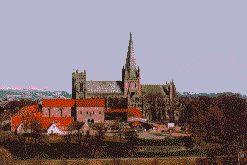 The cathedral and the archbishops palace, unfortunately the
palace is somewhat flamed, half of it burnt down a few years ago. It
will be rebuilt though, and probably burnt down again. We do
have a slight bit of problems with the anti-clerical movements here in Norway,
They have a tendency to set fire to churches without consent.
The small white building is a disputed local inn, due to its liberal alcohol
practices (they are actually selling it) on holy territory.
The cathedral and the archbishops palace, unfortunately the
palace is somewhat flamed, half of it burnt down a few years ago. It
will be rebuilt though, and probably burnt down again. We do
have a slight bit of problems with the anti-clerical movements here in Norway,
They have a tendency to set fire to churches without consent.
The small white building is a disputed local inn, due to its liberal alcohol
practices (they are actually selling it) on holy territory.
 Winter
view over the cathedral's riverside, taken from
the Student's Society,
This is where all the young people get drunk during the celebration of
the national day. Nasty thing.
Winter
view over the cathedral's riverside, taken from
the Student's Society,
This is where all the young people get drunk during the celebration of
the national day. Nasty thing.
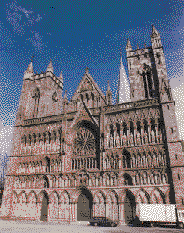 The western wall of the Cathedral, with
the rose window. That
window made it all the way into the town flag, and a discrete silver rose
is still used in patriot jewellery.
The western wall of the Cathedral, with
the rose window. That
window made it all the way into the town flag, and a discrete silver rose
is still used in patriot jewellery.
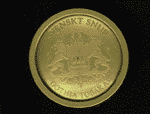
[A pictorial walk of the newly reshined docklands area, which is now my occupation, can be found here]
Historical photos
Full archive(>700 images)
More specific searches:
the tram,
bridges,
river,
areas,
churches,
monasteries,
the old harbour,
fortresses,
statues,
views,
the fjord,
the cathedral,
streets,
facades,
public life,
the harbour,
moods,
sailing ships,
crowds,
ice skating,
ski jumping,
skiing,
parks,
interiors,
mansions,
roads
Other sites covering Trondheim
English:
The cathedral pages
The city millennial 1997
Norwegian:
Official web-pages
A commercial city-guide
Colourful List of links on Trondheim
Kampen om Svartlamo'n
All images are linked up to various other
web-pages on Trondheim,
By the way: Do you know what "Nidaros" means
in Welsh?
with only the low-source
image stored locally. Track the image to get to the original
site.
According to the former EU ambassador
to Norway, himself Welsh, it means: